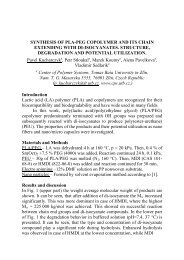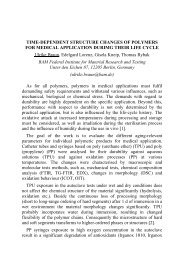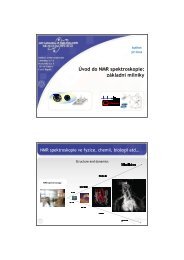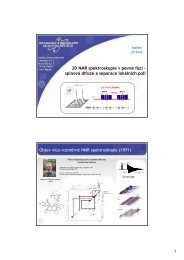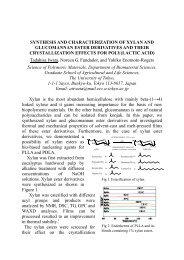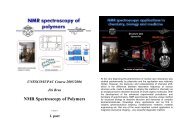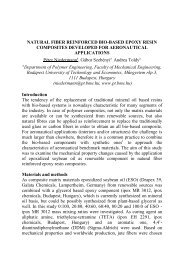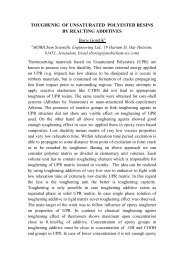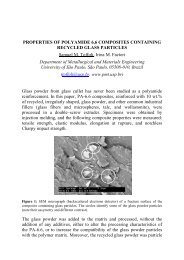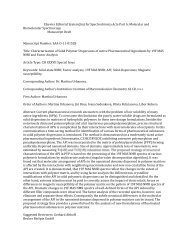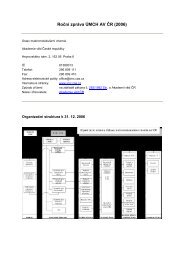(1R,2R)-1,2-diaminocyclohexane - Institute of Macromolecular ...
(1R,2R)-1,2-diaminocyclohexane - Institute of Macromolecular ...
(1R,2R)-1,2-diaminocyclohexane - Institute of Macromolecular ...
Create successful ePaper yourself
Turn your PDF publications into a flip-book with our unique Google optimized e-Paper software.
electronic reprint<br />
Acta Crystallographica Section C<br />
Crystal Structure<br />
Communications<br />
ISSN 0108-2701<br />
Editor: Anthony Linden<br />
A new [(<strong>1R</strong>,<strong>2R</strong>)-1,2-<strong>diaminocyclohexane</strong>]platinum(II)<br />
complex: formation by nitrate–acetonitrile ligand exchange<br />
Richard Pažout, Jitka Housková, Michal Dušek, Jaroslav Maixner, Jana<br />
Cibulková andPetrKačer<br />
Acta Cryst. (2010). C66, m273–m275<br />
Copyright c○ International Union <strong>of</strong> Crystallography<br />
Author(s) <strong>of</strong> this paper may load this reprint on their own web site or institutional repository provided that<br />
this cover page is retained. Republication <strong>of</strong> this article or its storage in electronic databases other than as<br />
specified above is not permitted without prior permission in writing from the IUCr.<br />
For further information see http://journals.iucr.org/services/authorrights.html<br />
Acta Crystallographica Section C: Crystal Structure Communications specializes in the<br />
rapid dissemination <strong>of</strong> high-quality studies <strong>of</strong> crystal and molecular structures <strong>of</strong> interest<br />
in fields such as chemistry, biochemistry, mineralogy, pharmacology, physics and materials<br />
science. The numerical and text descriptions <strong>of</strong> each structure are submitted to the<br />
journal electronically as a Crystallographic Information File (CIF) and are checked and<br />
typeset automatically prior to peer review. The journal is well known for its high standards<br />
<strong>of</strong> structural reliability and presentation. Section C publishes approximately 1000<br />
structures per year; readers have access to an archive that includes high-quality structural<br />
data for over 10000 compounds.<br />
Crystallography Journals Online is available from journals.iucr.org<br />
Acta Cryst. (2010). C66, m273–m275<br />
Pažout et al. · [Pt(C 2 H 3 N) 2 (C 6 H 14 N 2 )](NO 3 ) 2·H 2 O
metal-organic compounds<br />
Acta Crystallographica Section C<br />
Crystal Structure<br />
Communications<br />
ISSN 0108-2701<br />
<strong>of</strong> DACH with K 2 [PtCl 4 ], reacts with silver nitrate. The title<br />
compound, (I), crystallizes only from acetonitrile with residual<br />
water in such a way that the molecule forms a monohydrate.<br />
A new [(<strong>1R</strong>,<strong>2R</strong>)-1,2-<strong>diaminocyclohexane</strong>]platinum(II)<br />
complex:<br />
formation by nitrate–acetonitrile<br />
ligand exchange<br />
Richard Pažout, a * Jitka Housková, a Michal Dušek, b<br />
Jaroslav Maixner, a Jana Cibulková a and Petr Kačer a<br />
a <strong>Institute</strong> <strong>of</strong> Chemical Technology, Technická 5, Prague 166 28, Czech Republic,<br />
and b <strong>Institute</strong> <strong>of</strong> Physics, Czech Academy <strong>of</strong> Sciences, Na Slovance 2, 18221<br />
Prague 8, Czech Republic<br />
Correspondence e-mail: richard.pazout@vscht.cz<br />
Received 17 May 2010<br />
Accepted 17 August 2010<br />
Online 4 September 2010<br />
The title compound, cis-diacetonitrile[(<strong>1R</strong>,<strong>2R</strong>)-1,2-<strong>diaminocyclohexane</strong>-<br />
2 N,N 0 ]platinum(II) dinitrate monohydrate, [Pt-<br />
(C 2 H 3 N) 2 (C 6 H 14 N 2 )](NO 3 ) 2 H 2 O, is a molecular salt <strong>of</strong> the<br />
<strong>diaminocyclohexane</strong>–Pt complex cation. There are two<br />
formula units in the asymmetric unit. Apart from the two<br />
charge-balancing nitrate anions, one neutral molecule <strong>of</strong> water<br />
is present. The components interact via N—HO and O—<br />
HO hydrogen bonds, resulting in supramolecular chains.<br />
The title compound crystallizes only from acetonitrile with<br />
residual water, with the acetonitrile coordinating to the<br />
molecule <strong>of</strong> cis-[Pt(NO 3 ) 2 (DACH)] (DACH is 1,2-<strong>diaminocyclohexane</strong>)<br />
and the water forming a monohydrate.<br />
The single-crystal structure <strong>of</strong> (I) is built up from discrete<br />
moieties in the monoclinic space group P2 1 , with two formula<br />
units in the asymmetric unit. The [Pt(C 2 H 3 N) 2 (C 6 H 14 N 2 )] 2+<br />
complex cation is formed by one cyclohexane ring with a chair<br />
conformation, a five-membered diamine ring, a central Pt<br />
atom and two leaving groups <strong>of</strong> acetonitrile (N C—CH 3 ).<br />
This dication is balanced by two nitrate groups and one<br />
neutral water solvent molecule.<br />
The [Pt(C 2 H 3 N) 2 (C 6 H 14 N 2 )] 2+ cation is nearly planar, with<br />
the dihedral angle between the N1A/N2A/N3A/N4A plane<br />
and the cyclohexane plane (C3A/C6A/N1A/N2A) being<br />
approximately 5 . The Pt1A—N1A bond is shorter than the<br />
same bond in cis-[PtBr 2 (DACH)] and similar to that in cis-<br />
[PtCl 2 (DACH)] (Lock & Pilon, 1981). As for the two<br />
symmetry-independent cations <strong>of</strong> (I), they show few significant<br />
differences in bond distances and angles, apart from the<br />
Comment<br />
The search for novel platinum-based anticancer complexes<br />
remains an expanding area <strong>of</strong> the contemporary pharmaceutical<br />
industry. The driving force for investigations <strong>of</strong> this group<br />
<strong>of</strong> active anticancer therapeutics is the discovery <strong>of</strong> more<br />
active and less toxic analogues <strong>of</strong> the chemotherapy<br />
complexes used in today’s clinical practice (cisplatin, carboplatin,<br />
oxaliplatin, etc.) (Ho et al., 2003; Galanski et al., 2003;<br />
Abu-Surrah & Kettunen, 2006). Some <strong>of</strong> the novel structures<br />
are based on the platinum (<strong>1R</strong>,<strong>2R</strong>)-1,2-<strong>diaminocyclohexane</strong><br />
(DACH) carrier ligand and various leaving groups bound to<br />
the central Pt metal atom. There are several synthetic routes<br />
used for the preparation <strong>of</strong> DACH–platinum-based complexes<br />
(Fuertes et al., 2004; Leh & Wolf, 1976). One <strong>of</strong> the interesting<br />
routes for the preparation <strong>of</strong> oxaliplatin, AP5346 and other<br />
DACH–Pt complexes is the synthetic method starting from<br />
cis-[Pt(NO 3 ) 2 (DACH)]. This compound is a valuable<br />
precursor <strong>of</strong> the DACH–Pt-based cytostatics (Pasini et al.,<br />
1993). This is prepared by a simple method where cis-<br />
[PtCl 2 (DACH)], prepared by the quantitative transformation<br />
Figure 1<br />
The molecular structure <strong>of</strong> (I), showing the atom-numbering scheme.<br />
Displacement ellipsoids are drawn at the 50% probability level and H<br />
atoms are shown as small spheres <strong>of</strong> arbitrary radii.<br />
Acta Cryst. (2010). C66, m273–m275 doi:10.1107/S0108270110033135 # 2010 International Union <strong>of</strong> Crystallography m273<br />
electronic reprint
metal-organic compounds<br />
H(O,O) interactions linking an N atom <strong>of</strong> the diamine<br />
group with O atoms <strong>of</strong> a nitrate anion, and two O—HO<br />
chains linking an O atom <strong>of</strong> a nitrate anion to the water O<br />
atom. The first is parallel to [001] and takes the form<br />
(O1B,O3B) iii N2A vii (O2A,O3A)N5A(O1A,O3A)<br />
N2B ii (O2B,O3B) viii N5B viii (O1B,O3B) viii [all symmetry<br />
codes as in Table 1; additionally, (vii) x, y<br />
1<br />
2 , z +1;<br />
1<br />
(viii) x +1,y<br />
2<br />
, z + 2] (Fig. 2). Also present are chains<br />
parallel to [010] (Fig. 3) between a water molecule and nitrate<br />
anions, <strong>of</strong> the form O5AN6AO4AO7AO5A iii ; the<br />
second chain running parallel to the b axis is O5B ix <br />
O7B x O4B x N6B x O5B x [symmetry codes: (ix) x +1,<br />
y + 1 2<br />
, z + 1; (x) x, y, z 1]. Details <strong>of</strong> hydrogen bonds are<br />
given in Table 1 and the C—HO interactions are considered<br />
weak.<br />
Figure 2<br />
Bifurcated hydrogen-bonded chains formed by N—H(O,O) interactions<br />
along the c axis. H atoms not involved in the hydrogen bonding<br />
have been omitted for clarity. [Symmetry codes as in Table 1; additionally,<br />
1<br />
(vii) x, y<br />
2 , z + 1; (viii) x +1,y 1<br />
2 , z +2.]<br />
Experimental<br />
For the preparation <strong>of</strong> the title compound, an aqueous suspension<br />
(312 ml) <strong>of</strong> cis-[PtCl 2 (DACH)] (0.041 mol, 15.6 g) was mixed with<br />
1.935 equivalents <strong>of</strong> AgNO 3 (0.079 mol, 13.5 g) and the reaction<br />
mixture was stirred in the absence <strong>of</strong> light at 318 K for 4 h. The byproduct,<br />
AgCl, was removed by filtration through an ultra-filter (Ø =<br />
0.22 mm; Sigma–Aldrich) and a layer <strong>of</strong> active carbon. The colourless<br />
filtrate was evaporated and dried (Buchi Rotavapor RII rotary<br />
evaporator, 318 K, 2 kPa). The resulting white powder, crude cis-<br />
[Pt(NO 3 ) 2 (DACH)], was recrystallized from acetonitrile. Single<br />
crystals <strong>of</strong> cis-[Pt(CH 3 CN) 2 (DACH)](NO 3 ) 2 H 2 O, (I), suitable for<br />
X-ray diffraction analysis, were obtained from a solution <strong>of</strong> cis-<br />
[Pt(NO 3 ) 2 (DACH)] (3.1 mg, 0.0072 mmol) in acetonitrile (0.24 ml)<br />
by spontaneous precipitation under slow programmed cooling.<br />
Crystal data<br />
[Pt(C 2 H 3 N) 2 (C 6 H 14 N 2 )](NO 3 ) 2 -<br />
H 2 O<br />
M r = 533.4<br />
Monoclinic, P2 1<br />
a = 12.6799 (3) Å<br />
b = 12.0326 (3) Å<br />
c = 11.6791 (2) Å<br />
= 94.5495 (17) <br />
V = 1776.29 (7) Å 3<br />
Z =4<br />
Mo K radiation<br />
= 7.94 mm 1<br />
T = 120 K<br />
0.49 0.20 0.10 mm<br />
Figure 3<br />
The formation <strong>of</strong> two types <strong>of</strong> hydrogen-bonded chains parallel to the b<br />
axis. [Symmetry codes as in Table 1; additionally, (ix) x +1,y + 1 2 , z +1;<br />
(x) x, y, z 1.]<br />
analogous Pt1—N3—C7 angles, which are 178.6 (3) (cation A)<br />
and 174.1 (3) (cation B). Comparable torsion angles about<br />
the Pt atoms, e.g. N4—Pt1—N2—C2, differ by up to 8 in<br />
cations A and B. The N—O bonds in the NO 3 anions lie within<br />
expected ranges and these nitrate anions are positioned in<br />
such a manner that their O atoms are oriented towards the H<br />
atoms <strong>of</strong> adjacent water molecules and diamine groups,<br />
forming hydrogen bonds.<br />
There are three systems <strong>of</strong> supramolecular chains interacting<br />
by hydrogen bonds: one formed by bifurcated N—<br />
Data collection<br />
Oxford Xcalibur Atlas Gemini<br />
Ultra diffractometer<br />
Absorption correction: analytical<br />
[CrysAlis Pro (Oxford<br />
Diffraction, 2008), based on<br />
expressions derived by Clark &<br />
Reid (1995)]<br />
T min = 0.110, T max = 0.544<br />
Refinement<br />
R[F 2 >2(F 2 )] = 0.012<br />
wR(F 2 ) = 0.030<br />
S = 1.02<br />
7866 reflections<br />
480 parameters<br />
12 restraints<br />
16828 measured reflections<br />
7866 independent reflections<br />
7374 reflections with I >3(I)<br />
R int = 0.014<br />
H atoms treated by a mixture <strong>of</strong><br />
independent and constrained<br />
refinement<br />
max = 0.34 e Å 3<br />
min = 0.18 e Å 3<br />
Absolute structure: Flack (1983),<br />
with 3554 Friedel pairs<br />
Flack parameter: 0.027 (5)<br />
The title structure exhibits strong pseudosymmetry in the space<br />
group P2 1 /c. Using this symmetry, the cyclohexane ring showed<br />
disorder. After refinement in this space group, the R factors<br />
m274 Pažout et al. [Pt(C 2 H 3 N) 2 (C 6 H 14 N 2 )](NO 3 ) 2 H 2 O Acta Cryst. (2010). C66, m273–m275<br />
electronic reprint
metal-organic compounds<br />
Table 1<br />
Hydrogen-bond geometry (Å, ).<br />
D—HA D—H HA DA D—HA<br />
N1A—H1N1AO7B 0.870 (19) 2.030 (17) 2.892 (3) 171 (2)<br />
N1A—H2N1AO5A 0.87 (2) 2.44 (2) 3.232 (5) 151 (3)<br />
N1A—H2N1AO6A 0.87 (2) 2.21 (3) 3.013 (5) 154 (3)<br />
N2A—H1N2AO2A i 0.870 (14) 2.51 (2) 3.190 (4) 136 (2)<br />
N2A—H1N2AO3A i 0.870 (14) 2.207 (11) 3.023 (3) 156 (2)<br />
N2A—H2N2AO1B ii 0.87 (2) 2.05 (2) 2.914 (4) 174 (3)<br />
N2A—H2N2AO3B ii 0.87 (2) 2.54 (3) 3.064 (3) 119.4 (18)<br />
O7A—H1O7AO5A iii 0.80 (3) 2.00 (3) 2.802 (4) 175 (3)<br />
O7A—H2O7AO4A 0.80 (2) 2.019 (17) 2.757 (5) 153 (3)<br />
N1B—H1N1BO5B 0.87 (3) 2.32 (3) 3.090 (4) 148 (3)<br />
N1B—H1N1BO6B 0.87 (3) 2.63 (4) 3.207 (4) 125 (3)<br />
N1B—H2N1BO7A 0.87 (3) 1.95 (4) 2.813 (4) 171 (5)<br />
N2B—H1N2BO1A iv 0.87 (3) 2.10 (3) 2.936 (4) 160 (2)<br />
N2B—H1N2BO3A iv 0.87 (3) 2.53 (3) 3.238 (3) 140 (3)<br />
N2B—H2N2BO2B v 0.87 (3) 2.43 (4) 3.213 (4) 150 (4)<br />
N2B—H2N2BO3B v 0.87 (3) 2.21 (2) 3.005 (3) 152 (4)<br />
O7B—H1O7BO5B vi 0.80 (3) 2.02 (3) 2.818 (4) 177 (3)<br />
O7B—H2O7BO4B 0.800 (14) 2.059 (14) 2.846 (5) 168 (3)<br />
Symmetry codes: (i) x; y þ 1 2 ; z þ 1; (ii) x 1; y; z; (iii) x þ 1; y 1<br />
2<br />
; z þ 1; (iv)<br />
1<br />
x þ 1; y; z; (v) x þ 2; y 2<br />
; z þ 2; (vi) x þ 1; y þ 1 2 ; z þ 2.<br />
converged to 0.042, but large anisotropic displacement parameters<br />
(ADPs) were shown by the nitrate atoms and three <strong>of</strong> the six C atoms<br />
<strong>of</strong> the cyclohexane ring. These C atoms were split and the ADPs<br />
changed to isotropic, and two chairs appeared with the refinement<br />
converging to 0.039 and a goodness-<strong>of</strong>-fit <strong>of</strong> 0.023. However, the H<br />
atoms <strong>of</strong> the water molecule and diamine groups were not visible in<br />
the difference Fourier map. Therefore, the sample was remeasured at<br />
a lower temperature, which showed that the reflections violating the<br />
c-glide plane condition were real violations, not admixtures present in<br />
low-quality data. Therefore, the model was transformed to subgroup<br />
P2 1 . For expansion <strong>of</strong> the structure model, the inversion was used as a<br />
merohedral twinning operation. In this case, the volume fraction <strong>of</strong><br />
the inversion twin is the Flack parameter (Flack, 1983). This parameter<br />
refined to a final value <strong>of</strong> 0.027 (5), which confirms both that<br />
the above configuration is the correct absolute structure and that<br />
there is no twinning in the crystal structure. The noncentrosymmetric<br />
refinement converged to R factors close to 0.01, gave reasonable<br />
ADPs for the C atoms in the cyclohexane ring and all H atoms were<br />
visible in the difference Fourier maps. There are no significant<br />
differences between the individual cations in the space groups P2 1<br />
and P2 1 /c, apart from the disorder <strong>of</strong> the C atoms in the cyclohexane<br />
ring shown in P2 1 /c which is non-existent in P2 1 . As to the two cations<br />
in the asymmetric unit in P2 1 , they show few significant differences in<br />
bond distances and angles, but several are noted for the torsion<br />
angles.<br />
O- and N-bound H atoms were refined with N—H distances<br />
restrained to 0.87 (2) Å and O—H distances restrained to 0.80 (3) Å.<br />
All other H atoms were positioned geometrically and refined using a<br />
riding model, with C—H = 0.96 Å and U iso (H) = 1.2U eq (C).<br />
Data collection: CrysAlis Pro (Oxford Diffraction, 2008); cell<br />
refinement: CrysAlis Pro (Oxford Diffraction, 2008); data reduction:<br />
CrysAlis Pro; program(s) used to solve structure: SUPERFLIP<br />
(Palatinus & Chapuis, 2007); program(s) used to refine structure:<br />
JANA2006 (Petříček et al., 2006); molecular graphics: ORTEP-3<br />
(Farrugia, 1999) and Mercury (Version 2.3; Macrae et al., 2006);<br />
s<strong>of</strong>tware used to prepare material for publication: JANA2006.<br />
This work was supported by grant No. MSM 6046137301<br />
and research programme 2B08021 <strong>of</strong> the Ministry <strong>of</strong> Education,<br />
Youth and Sports <strong>of</strong> the Czech Republic, and by grant<br />
No. MPO 2A-2TP1/049 from the Ministry <strong>of</strong> Industry and<br />
Trade <strong>of</strong> the Czech Republic. We also acknowledge institutional<br />
research plan No. AVOZ10100521 <strong>of</strong> the <strong>Institute</strong> <strong>of</strong><br />
Physics <strong>of</strong> the Czech Academy <strong>of</strong> Sciences.<br />
Supplementary data for this paper are available from the IUCr electronic<br />
archives (Reference: GG3238). Services for accessing these data are<br />
described at the back <strong>of</strong> the journal.<br />
References<br />
Abu-Surrah, A. S. & Kettunen, M. (2006). Curr. Med. Chem. 13, 1337–1357.<br />
Clark, R. C. & Reid, J. S. (1995). Acta Cryst. A51, 887–897.<br />
Farrugia, L. J. (1999). J. Appl. Cryst. 32, 837–838.<br />
Flack, H. D. (1983). Acta Cryst. A39, 876–881.<br />
Fuertes, M. A., Castilla, J. & Nguewa, P. A. (2004). Med. Chem. Rev. Online, 1,<br />
187–198.<br />
Galanski, M., Arion, V. B., Jakupec, M. A. & Keppler, B. K. (2003). Curr.<br />
Pharm. Des. 9, 2078–2089.<br />
Ho, Y.-P., Au-Yeung, S. C. F. & To, K. K. W. (2003). Med. Res. Rev. 23, 633–655.<br />
Leh, F. K. V. & Wolf, W. (1976). J. Pharm. Sci. 65, 315–328.<br />
Lock, C. J. L. & Pilon, P. (1981). Acta Cryst. B37, 45–49.<br />
Macrae, C. F., Edgington, P. R., McCabe, P., Pidcock, E., Shields, G. P., Taylor,<br />
R., Towler, M. & van de Streek, J. (2006). J. Appl. Cryst. 39, 453–457.<br />
Oxford Diffraction (2008). CrysAlis Pro. Oxford Diffraction Ltd, Yarnton,<br />
Oxfordshire, England.<br />
Palatinus, L. & Chapuis, G. (2007). J. Appl. Cryst. 40, 786–790.<br />
Pasini, A., Caldriola, C. & Spinelli, S. (1993). Synth. React. Inorg. Met. Org.<br />
Nano-Met. Chem. 23, 1021–1060.<br />
Petříček, V., Dušek, M. & Palatinus, L. (2006). JANA2006. <strong>Institute</strong> <strong>of</strong> Physics,<br />
Czech Academy <strong>of</strong> Sciences, Prague, Czech Republic.<br />
Acta Cryst. (2010). C66, m273–m275 Pažout et al. [Pt(C 2 H 3 N) 2 (C 6 H 14 N 2 )](NO 3 ) 2 H 2 O m275<br />
electronic reprint



